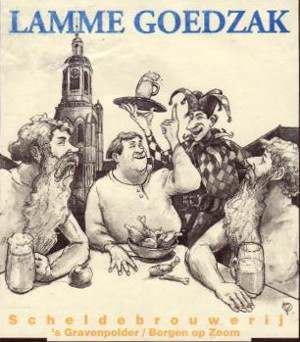ABV: 6.5%
Origin: Bergen op Zoom, Noord-Brabant, Netherlands
Website: www.scheldebrouwerij.com
Date: 8 September 2000
Another review from the archive written for the pioneering Oxford Bottled Beer Database (OBBD). I’ve left it uncorrected — so please read it in that historical spirit.
Scheldebrouwerij, founded in 1994 and named after the Schelde river, became one of the few border-crossing microbreweries in 2007 when it moved to Meer, just across the Belgian border in Antwerpen province. It remained in Dutch ownership, brewing the same brands largely aimed at the Dutch market, but the kudos of being a Belgian brewer resulted in a marked increase in sales.
Lamme Goedzak is still in the range, though its ABV has been raised to 7%. It is indeed named after the character from the Tijl Uilenspiegel stories that I describe, although not from the original folk tales but from their 1867 retelling by author Charles de Coster. Once again I seem to have had a notable sensitivity to hops.
This Zeeland [actually Noord-Brabant]-based craft brewery seems to have become a regular fixture at the Great British Beer Festival and 2000 brought another batch of specialities. Lamme Goedzak is, if I remember rightly, a fat and jolly character who plays comedy sidekick to Flemish folk hero Tijl Uilenspiegel in the traditional stories, and there he is on the label against a backdrop of the towers of Bruges, stuffing his face with chicken legs and about to quaff a foaming mug of ale.
The beer inside, however, is far too austerely hoppy and also rather too strong for jolly quaffing fodder. Though described as a golden ale, it’s deep enough to be a pale and its hop character edges it in that direction too. Poured without the sediment as recommended on the label, the beer throws a thick and persistent head that offers up a rich aroma of spicy hop with some phenolic notes, reminiscent of ginger marmalade on toast.
The condition is lively, and the hops are immediately prominent in the mouth as well, set against a background of honeyed malt (the beer contains candy sugar) and hints of perfumed fruitiness with lime and pineapple. The hops continue to assert themselves through a grapefruit-dry finish, and linger long after the last swallow. The overall effect isn’t dissimilar to one of those ultra-hoppy pale ales from the USA, though the candy sugar and aromatic German hops give it a Belgian abbey flourish that ventures into Orval territory, but with little of the latter’s complexity.
A well-made beer, then, but it could do with being either more subtle or, given the cheerful presentation, less forbidding in its bitterness.






Leave a Reply